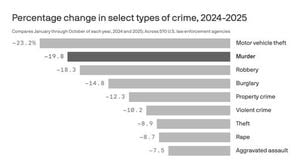As the dust settles after the November 5, 2025, elections, Democrats across the country are savoring a string of victories that stretch from the reliably blue strongholds of New Jersey and Virginia to the deep-red heart of Tioga County, New York. While the headlines have focused on the big-ticket wins in gubernatorial races, the story unfolding in America’s local communities may offer an even more intriguing glimpse into the nation’s shifting political landscape.
According to The Washington Post, Democrats not only held onto their traditional bases in states like New Jersey and Virginia, but they did so with margins that surprised even seasoned political observers. These states, which have long leaned Democratic, nonetheless saw their candidates outperform Vice President Kamala Harris’s showing in the 2024 election. Dr. Patrick Flavin, chair of the political science department at Baylor University, described these results as a “general takeaway that Democrats did really well.” He noted, “[These elections] are sort of an early progress report on how the president and the president’s party are doing.”
What’s especially noteworthy isn’t just that Democrats won in blue states—after all, as Flavin pointed out, “New Jersey, Virginia, California and New York are all blue states; it makes sense that they would elect Democratic representatives.” Rather, it’s the scale of the victories and the issues that drove them, particularly when compared to the 2024 election cycle. The Washington Post reported that these races were expected to be much closer, especially in New Jersey, a state that had “shifted to the right more than any state besides New York last fall.” The decisive wins, then, signal that voter sentiment may be shifting again, and not in the direction many pundits predicted.
Affordability emerged as the defining issue of the 2025 election cycle. Voters from coast to coast voiced concerns about the rising cost of living, a trend that analysts say could dominate the narrative heading into the 2026 midterms. “Voters are unhappy with how the Trump administration is going so far in terms of affordability,” Flavin said. This dissatisfaction, he explained, should serve as a “wake-up call” for the administration. “This is probably a wake-up call that the voters are displeased and that [the Trump administration] needs to address that.”
But the national story is only half the tale. In Tioga County, New York—a region where Republican dominance stretches back to the 1800s—Democrats Jo Ellen Rose and Emily McClintock pulled off a pair of upset victories that have stunned local political watchers. As reported by WIVT/WBGH, Rose won a seat on the Tioga County Legislature, while McClintock was elected to the Town of Owego Board. Both women will be the only Democrats on their respective governing bodies—a testament to just how rare these wins are in this part of upstate New York.
Rose, who succeeded retiring legislator Marte Sauerbrey, brings decades of experience in human resources and human services, including leadership roles at Racker and Catholic Charities of Tompkins and Tioga. She didn’t mince words about the challenges of breaking into a political scene long dominated by the GOP. “When you have a party so solidly entrenched, and we’re talking going back to the 1800’s for Tioga County, so solidly entrenched, it builds complacency. I didn’t feel that people were being heard. I didn’t feel that the legislators were responsive enough to people’s concerns,” Rose said.
McClintock, a mental health therapist at Cornell University, ran her campaign on a platform of accountability and affordability—echoing the themes that resonated nationally. She credited Rose with encouraging her to run, and Democratic Committee Vice Chair Irena Raia with helping her navigate the complexities of an underdog campaign. “She was the first person I talked to and she talked to me about what it was going to look like. What time commitment I had to have for that. Irena was so supportive in terms of figuring out messaging, in terms of figuring out what are those next steps and what am I doing day to day. If I didn’t have that support, I honestly don’t know that I would have been able to run because it is a complicated process sometimes,” McClintock said.
Their victories were not simply the result of tireless grassroots organizing—though both campaigns leaned heavily on volunteers and local networks—but were also buoyed by a wave of anti-Trump sentiment among Democrats and independents. As Rose and McClintock see it, this energy helped catch local Republicans “flat-footed” when their campaigns ramped up in September. Their shared goals now include improving transparency and accessibility in local government, and, perhaps just as importantly, inspiring other Democrats to run in areas where their party has long been outnumbered.
Back on the national stage, the results from New Jersey and Virginia are being closely scrutinized for what they reveal about the electorate’s mood heading into the all-important 2026 midterms. Flavin explained that these state-wide general elections are more than just local contests—they’re bellwethers for voter satisfaction and serve as guideposts for both parties as they plot strategy for the coming year. “These elections were a sneak peek for voters into how the 2026 midterms could play out,” he said.
Political uncertainty remains a constant undercurrent, with voters expressing anxiety over issues ranging from tariffs to the threat of government shutdowns. “There’s probably a general perception that there’s a lot of policy uncertainty in terms of tariffs being instituted and then revoked and the government being shut down,” Flavin noted. For swing voters, this uncertainty may be just as important as any single policy issue. “I think for a voter who’s potentially open to voting for either party, they take out all this uncertainty and say that they’re concerned by it.”
For younger voters and those far from the action, the message is clear: pay attention, even if the races aren’t in your backyard. Princeton freshman Anita Axelson put it succinctly: “Even though you may not live in New Jersey, they’re still American, and while the impacts may not be obvious, it still changes the way things are a little bit.”
As Democrats celebrate hard-fought wins in both expected and unlikely places, the 2025 elections have provided a revealing snapshot of the American political climate—a climate marked by economic anxiety, grassroots determination, and a growing appetite for change. With the 2026 midterms looming, both parties will be watching closely to see whether the trends of this year hold steady, or if another political surprise is just around the corner.






